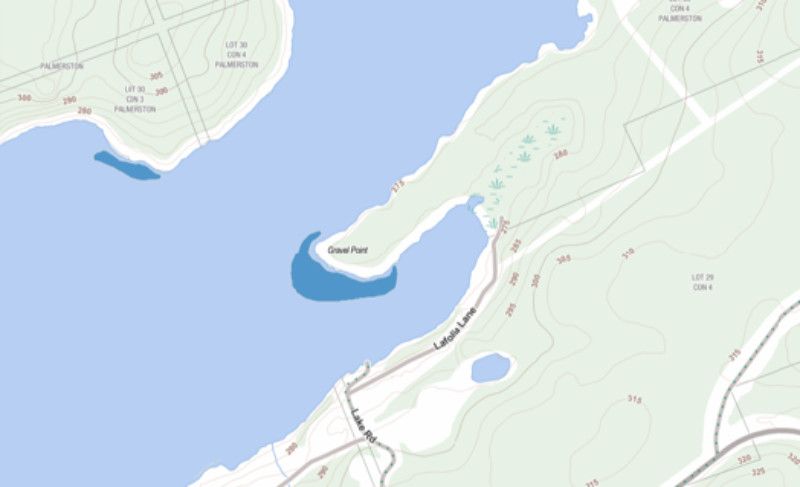Jeff Green | Feb 21, 2024
A proposed family based land use co-op on Palmerston Lake in North Frontenac has attracted the attention of The Ontario Federation of Anglers and Hunters.
The Hall family from Almonte, including Amber and Craig Hall from Equator Coffee, came to North Frontenac Council a year ago with a plan to establish a co-op that could include as many as 8 cottages, 3 docks, 3 gazebos, a number of bunkies and some shared buildings, on a 35 acre parcel of land with 1200 feet of shoreline.
The property is located just past the end of Lafola Lane, which is off Lake Road, close to Ompah and Road 509.
There is currently one cottage on the property. The Hall's proposal is to limit the size of the 7 new cottages to 1600 square feet, and to keep them all outside of the 30 metre setback from the high water mark of the lake, which is the standard for waterfront development in North Frontenac, and the province as a whole. The gazebos, however, and a marine storage shed, could be located within the 30 metre setback.
The proposed zoning for the co-op would preclude any commercial use of the property.
The Hall's note that there is a precedent for a land co-op in the township, as the Lothlorian co-op south of Ompah (but not on water) has been in place since the early 1970s.
When the proposal came to a meeting last year, there were a number of issues raised by neighbours who were concerned about density and some other issues.
A number of further reports are necessary before the necessary rezoning of the land can take place, before formally setting up the co-op. Then each of the co-op owners will be responsible for their own building projects, which could take up to 20 years to all be completed.
Some of the neighbours on the lake thought there was a glaring omission from the planning documents that were presented last year, the fact that the largest trout spawning bed on Palmerston Lake is located off of Gravel Point, and three of the proposed cottage lots are located directly at the point, with only a sloped gravel patch between the cottages and the lake. They met with township staff and the contract planner last year, to provide information about the spawning bed.
While there are restrictions to development, for what the Province of Ontario classes as “At Capacity” trout sensitive lakes (including a 300 metre setback for any new construction) Palmerston is a trout lake that is not at capacity.
In November, the Ontario Federation of Anglers and Hunters (OFAH) sent a letter to North Frontenac Council regarding the matter. The letter, which was written by OFAH fisheries biologist Adam Weir, said that the OFAH “isn’t inherently opposed to a low impact project design with sufficient monitoring, reporting, and potential offsetting,” it is concerned, however, that the environmental assessment report for the project, which was completed in 2021 by GEMTEC Engineering of Ottawa, “was grossly inadequate and may not even meet its legislative requirements.”
That GEMTEC assessment did not make any reference to the spawning bed.
Noting that omission, the OFAH said in their letter, “At a minimum, we would expect detailed baseline information to be gathered, accounting for temporal and seasonal variations, monitoring during the construction period, as well as implementing a post-construction monitoring plan that includes detailed reporting.”
The letter points out that the OFAH opinion on the matter is based on the Fisheries Act, which states in section 35(1) “No person shall carry on any work, undertaking or activity that results in the harmful alteration, disruption or destruction of fish habitat.”
The letter adds: “From the OFAH’s perspective, there has been blatant disregard for fish habitat during this process. At roughly 11,800 square metres in size, the single largest recorded Lake Trout spawning habitat on the entirety of Palmerston Lake exists at Gravel Point. Development close to this location during any time of year, but especially during the fall, could have serious and unacceptable consequences on the fish and fish habitat.”
It makes several recommendations for the township and the applicants to consider as they carry this project further.
They include; consulting with Fisheries and Oceans Canada to determine how the Fisheries Act applies; increased monitoring; a 33 metre setback for all structures in the development; adhering to spring and fall spawning windows for all construction activities at the site; reworking the Environmental Impact Assessment to account for the spawning beds; providing alternative configurations for the location of cottages and septic beds; and relocating docks.
The project remains in the planning stages.
More Stories
- Latest CUPW Job Action Stops Postal Delivery Of The Frontenac News Forcing Alternate Plans
- Opponents of Barbers Lake Gravel Pit Pack Ag Hall in McDonalds Corners
- Bobsleigh Olympian Jay Dearborn At Mikes Pizza In Sydenham
- The Loins Club Of and O'Lakes Roar
- North Frontenac Back Roads Studio Tour - September 27 and 28
- Sunday Market Vendors Give Back
- George Street Work As Town Hall Renovation Nears Completion
- One Way Street Plan Hits A Dead End - Central Frontenac Council, September 9
- Global Gardening
- No Winner Yet in Catch The Ace But Fundraising Target Met

